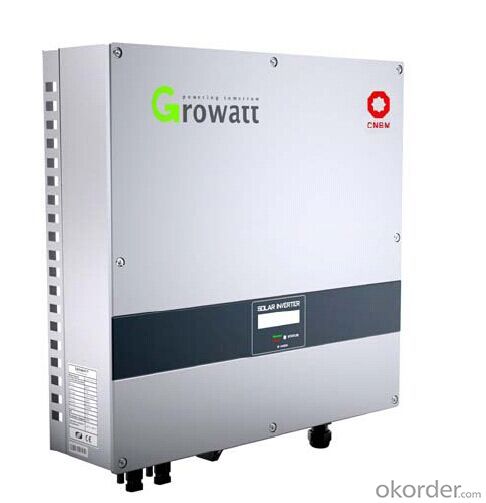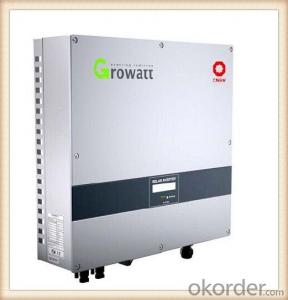Titan Solar Inverter CNBM-12000UE Grid-Tie Solar Inverter with Energy Storage Hybrid Solar Inverter
- Loading Port:
- China main port
- Payment Terms:
- TT OR LC
- Min Order Qty:
- 1000 watt
- Supply Capability:
- 100000 watt/month
OKorder Service Pledge
OKorder Financial Service
You Might Also Like
Introduction
CNBM-10000UE
CNBM-12000UE
CNBM-18000UE
CNBM-20000UE
Maximum efficiency of 97.9% and wide
input voltage range
Wide MPPT voltage
Internal DC switch
Transformerless GT topology
Compact design
MTL – String
Multi-MPPT
Certificate: CE, VDE 0126-1-1,
DK5940, G83/1-1, G59/2, RD1663,
EN50438, VDE-AR-N4105, CEI-021,
IEC-62109, ENEL-Guide, UL1741,
UL1998, IEEE1547, CSA
Warranty: 5/10 years
Features
Maximum efficiency of 97.9% and wide input voltage range
Internal DC switch
MTL-String
Bluetooth/RF technology /wifi
Transformerless GT topology
5 years warranty(10years as optional)
Images



Sepecification


FAQ
Q1: How to choose a right inverter?
A1:Tell us your demand, then our sales will recommend a suitable inverter to you.
Q2: What's the different between inverter and solar inverter?
A2: Inverter is only accept AC input, but solar inverter not only accept AC input but also can connect with solar panel to accept PV input, it more save power.
Q3: How about the delivery time?
A3: 7 days for sample; 25 days for bulk order.
Q4: What is the warranty of inverter?
A4: 5/10 years warranty on CNBM-Solar product.
Q5: How to solve the technical problem?
A5: 24 hours after-service consultancy just for you and to make your problem to solve easily.
Q6: What is the lead time?
A6: One day after reveiving the payment.
Q7: Can I have a sample order?
A7: Yes, we welcome sample order to test and check quality. Mixed samples are acceptable.
Q8: How do you ship the goods and how long does it take arrive?
A8: Express (DHL,UPS,Fedex or TNT), Air or Sea shipment is available depends on your need. It usually takes 3-5 days to arrive except Sea transportation.
- Q: Can a solar inverter be used with a solar-powered water pumping system?
- Yes, a solar inverter can be used with a solar-powered water pumping system. The solar inverter converts the direct current (DC) produced by the solar panels into alternating current (AC), which is necessary to power the water pump. By utilizing a solar inverter, the energy generated by the solar panels can be efficiently transferred to the water pumping system, allowing it to operate using clean and renewable energy.
- Q: What is the role of a solar inverter in voltage and frequency regulation during islanding conditions?
- The solar inverter plays a crucial role in maintaining voltage and frequency regulation during islanding conditions. Islanding conditions occur when a distributed generation system, like a solar PV system, continues to supply power to a local area even when the main electrical grid is disconnected. In grid-connected mode, the solar inverter synchronizes its output voltage and frequency with the utility grid. However, during islanding conditions, it must transition into a standalone mode and take responsibility for regulating voltage and frequency within the isolated microgrid. The primary function of the solar inverter in islanding conditions is to ensure that the voltage and frequency of the generated electricity remain within acceptable limits. To achieve this, it constantly monitors the electrical parameters and adjusts its own output accordingly. To regulate voltage, the solar inverter adjusts its output voltage based on demand and the available power from the solar panels. It maintains a steady voltage level within a specified range, typically around 230-240 volts for residential applications. Equally important is frequency regulation, which ensures that the electrical devices connected to the microgrid operate at their designed frequency, usually 50 or 60 Hz. The solar inverter continuously monitors the frequency and adjusts its output to match the required frequency, minimizing fluctuations and maintaining stability. Apart from voltage and frequency regulation, the solar inverter also performs other crucial functions during islanding conditions. These include power quality control, protection against overvoltage and overcurrent, and safe disconnection in emergencies or during grid restoration. Overall, the solar inverter's role in voltage and frequency regulation during islanding conditions is critical for maintaining a stable and reliable power supply within the isolated microgrid. It ensures that the electricity generated by the solar PV system remains within acceptable parameters, enabling connected electrical devices to operate efficiently and safely.
- Q: What is the role of a solar inverter in a solar power system?
- The role of a solar inverter in a solar power system is to convert the direct current (DC) electricity generated by the solar panels into alternating current (AC) electricity that can be used to power household or commercial appliances and feed excess energy back into the grid.
- Q: How does a solar inverter handle islanding detection and prevention?
- A solar inverter handles islanding detection and prevention by continuously monitoring the electrical grid's stability. It utilizes anti-islanding protection mechanisms to detect any abnormal conditions, such as voltage fluctuations or frequency deviations, that may indicate the presence of an islanded grid. In the event of islanding, the inverter immediately disconnects from the grid to prevent energy feed-in and effectively isolate the solar system. This ensures the safety of utility workers, prevents damage to equipment, and helps maintain the stability of the overall electrical grid.
- Q: Can a solar inverter be used in parallel configurations for increased power output?
- Yes, a solar inverter can be used in parallel configurations for increased power output. By connecting multiple inverters in parallel, the overall power output can be increased, allowing for the utilization of larger solar arrays and maximizing the energy generation capacity.
- Q: Can a solar inverter be used in a solar water pumping system?
- Yes, a solar inverter can be used in a solar water pumping system. The inverter is responsible for converting the direct current (DC) generated by the solar panels into alternating current (AC) required to power the water pump. This allows for efficient and reliable operation of the pumping system using solar energy.
- Q: How does a solar inverter monitor and optimize energy production?
- A solar inverter monitors and optimizes energy production by converting the direct current (DC) generated by solar panels into alternating current (AC) that can be used to power electrical devices. It constantly monitors the voltage and current of the solar panels to ensure optimal performance and adjusts the conversion process accordingly. Additionally, advanced solar inverters often incorporate maximum power point tracking (MPPT) technology, which enables them to track the maximum power output of the solar panels and adjust their operating parameters accordingly, maximizing energy production. This monitoring and optimization process helps to ensure efficient and effective utilization of solar energy.
- Q: How does a solar inverter handle voltage sags and swells?
- A solar inverter handles voltage sags and swells by constantly monitoring the grid voltage. When a sag or swell is detected, it quickly adjusts its output voltage accordingly to ensure a stable and consistent flow of power to the connected solar panels. This helps protect the panels from potential damage and maintains optimal performance.
- Q: What is the role of a solar inverter in preventing overloading?
- The role of a solar inverter in preventing overloading is to regulate the flow of electricity from the solar panels to the grid or the connected load. It continuously monitors the power output of the solar panels and adjusts the voltage and frequency to match the requirements of the load. By doing so, it ensures that the system does not exceed its capacity, preventing overloading and potential damage to the equipment.
- Q: What is the role of a solar inverter in a solar-powered desalination system?
- The role of a solar inverter in a solar-powered desalination system is to convert the direct current (DC) electricity generated by the solar panels into alternating current (AC) electricity that can be used to power the desalination process. The inverter ensures that the energy produced by the solar panels is compatible with the desalination system, allowing it to operate efficiently and effectively.
Send your message to us
Titan Solar Inverter CNBM-12000UE Grid-Tie Solar Inverter with Energy Storage Hybrid Solar Inverter
- Loading Port:
- China main port
- Payment Terms:
- TT OR LC
- Min Order Qty:
- 1000 watt
- Supply Capability:
- 100000 watt/month
OKorder Service Pledge
OKorder Financial Service
Similar products
Hot products
Hot Searches
Related keywords



























